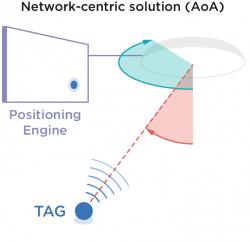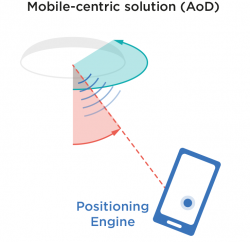Understanding AoA and AoD: What do they mean for location?

Fabio Belloni of Quuppa
Accurate location capabilities have become an important business enabler for many organisations across a variety of industries as they use Internet of Things (IoT) capabilities to make processes more efficient, better understand employee and customer behaviour, and more effectively monitor and manage their key assets, says Fabio Belloni, chief customer officer and cofounder of Quuppa.
Use cases span everything from tracking game and player analysis and fan engagement in sports to improving process optimisation and quality assurance in manufacturing and logistics.
Among the several options for location technology, Bluetooth has emerged as one of the early leaders, finding the sweet spot between cost (through the widescale availability of low-cost tags and locators) and accuracy (down to 10cm, based on the use case).
Bluetooth-based location got a further boost in January, when the Bluetooth Special Interest Group (Bluetooth SIG) announced a new direction finding feature as part of version 5.1 of the Bluetooth Core Specification. The new release formally adds directional capabilities to Bluetooth proximity solutions, with the goal of providing higher levels of accuracy for Bluetooth-based real-time location systems (RTLS).
The direction finding feature contains two methodologies: the Angle of Arrival (AoA) and Angle of Departure (AoD). There are similarities between the two—each utilise angular direction estimation to determine positioning, for example—but each has benefits that make it the best solution for particular market segments. Note that in principle, the same RTLS can be used to enable both AoA and AoD, simultaneously.
Angle of Arrival
AoA is already in commercial use today across a wide range of industries and use cases, such as asset tracking in industrial IoT (IIoT). The AoA methodology utilises a network-centric architecture where a tag or smartphone is tracked by its position using a single antenna to make its location known. A multi-antenna device called a Locator receives the radio signal from the tag or smartphone and pre-processes the data to estimate the angle. The data is then sent to a positioning engine, which further processes the data coming from the Locator and computes the location coordinates of the tag (see Diagram 1).
For most IIoT applications, the location coordinates information is only retained within the on-premises network or in the cloud for feeding the location-based service (LBS) application software.

Because the intelligence is in the network and not the device, AoA is highly effective for industrial and enterprise use cases that require consistently reliable location capabilities with low-cost tags.
Angle of Departure
Meanwhile, AoD is not currently in use on a wide scale but has growing interest in use cases such as wayfinding, robotics, automated guided vehicles (AGVs) and artificial intelligence (AI) applications where the moving object (which could be a smartphone, tablet or robot) has the intelligence to compute its own location. AoD has the system capacity and scale to be successful in the consumer market (B2C) and will benefit from the participation of the software operating system (OS) and hardware original design manufacturer (ODM) providers.
With AoD, each device has a single antenna and directly runs the positioning engine. The device receives the radio signal transmitted by the multi-antenna Locator. In this mobile-centric architecture, the power consumption is on the device side (however, devices such as smart phones are easily recharged). In AoD, the Locators could be configured as a low-power device with long battery life, similarly to tags in AoA systems. Because only a few Locators are needed to cover the area being tracked, AoD offers both the system capacity and scale required for consumer use cases (see Diagram 2).

The introduction of the direction finding feature as part of the Bluetooth 5.1 specification has raised industry interest in location. The feature defined the radio interface up to low-level IQ data samples but has left the interpretation of the location system architecture to individual RTLS companies. A few have already successfully built additional capabilities on top of the standard using IQ data combined with their own algorithms, software tools, and positioning engine.
As the IoT scales, accurate location capabilities are becoming an important business enabler. To find future success, the industry requires open, flexible systems that help organisations achieve their key business goals. Utilising RTLS that support both AoA and AoD on the same system will further help companies drive ROI from location capabilities.
The author is Fabio Belloni, chief customer officer and co-founder, Quuppa
About the author
Fabio Belloni is chief customer officer and cofounder of Quuppa, focusing on accelerating the success of its partner companies. He is a frequent contributor and the author or co-author of numerous academic papers, and has several granted patents and pending patent applications.
Comment on this article below or via Twitter @IoTGN
